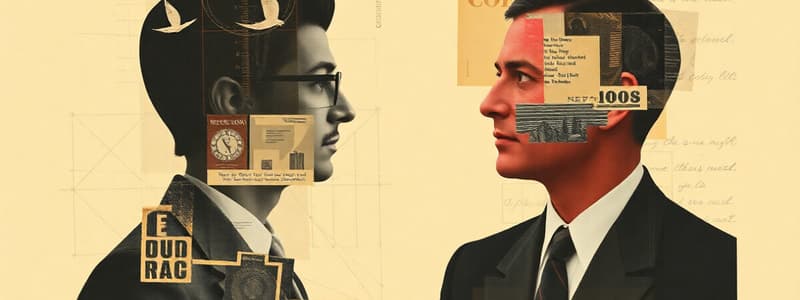Podcast
Questions and Answers
What is a key characteristic of the new contract proposed in the discussion?
What is a key characteristic of the new contract proposed in the discussion?
- Workers receive only commission without a base pay.
- Workers earn a fixed base pay as long as they keep their job. (correct)
- Workers are paid a flat fee regardless of sales performance.
- Workers must sell more than Q0 to earn any incentive pay. (correct)
What happens if the draw, D, is set too generously in the incentive pay plan?
What happens if the draw, D, is set too generously in the incentive pay plan?
- The agent will always achieve their sales targets.
- Point n will lie below the indifference curve.
- The agent may become less motivated to sell higher amounts. (correct)
- The fixed base pay will become irrelevant for performance.
Which of the following correctly describes the relationship between the draw, D, and the output needed to maintain job security, Q0?
Which of the following correctly describes the relationship between the draw, D, and the output needed to maintain job security, Q0?
- D must be equal to Q0 for the contract to be effective.
- D should be generous to ensure job retention regardless of sales.
- D cannot be too generous relative to the required output, Q0. (correct)
- D must always exceed Q0 to motivate the worker.
What condition must be met for the new incentive plan to yield the same results as the original pay plan?
What condition must be met for the new incentive plan to yield the same results as the original pay plan?
In the proposed new contract, what happens if the worker sells less than the minimum required amount?
In the proposed new contract, what happens if the worker sells less than the minimum required amount?
What is described as the ‘franchise solution’ to the principal-agent problem?
What is described as the ‘franchise solution’ to the principal-agent problem?
What does the phrase ‘Buy, don’t make’ imply in a business context?
What does the phrase ‘Buy, don’t make’ imply in a business context?
What does the participation constraint require in terms of agent utility?
What does the participation constraint require in terms of agent utility?
What is a reason workers may hesitate to make a large up-front payment for a job?
What is a reason workers may hesitate to make a large up-front payment for a job?
What relationship is established between base pay and target utility in the principal’s problem?
What relationship is established between base pay and target utility in the principal’s problem?
In the context of implicit payment for jobs, what does building the entry fee into the worker's pay schedule allow?
In the context of implicit payment for jobs, what does building the entry fee into the worker's pay schedule allow?
What is the implication of setting a 100% commission rate for the agent's pay?
What is the implication of setting a 100% commission rate for the agent's pay?
How does a commission-based pay affect a worker's income according to the principal-agent problem?
How does a commission-based pay affect a worker's income according to the principal-agent problem?
Why might a worker's income be less than what they produce, leading to profits being shown as a vertical distance on a graph?
Why might a worker's income be less than what they produce, leading to profits being shown as a vertical distance on a graph?
What does the incentive compatibility constraint relate to in the principal’s problem?
What does the incentive compatibility constraint relate to in the principal’s problem?
What happens when a worker cannot afford to pay upfront for a job?
What happens when a worker cannot afford to pay upfront for a job?
Why might a principal not need to give an agent as much pay to achieve a certain utility level?
Why might a principal not need to give an agent as much pay to achieve a certain utility level?
In deriving the profit function in the principal’s problem, which step involves taking the derivative with respect to base pay?
In deriving the profit function in the principal’s problem, which step involves taking the derivative with respect to base pay?
Which of the following best describes agency problems in a business context?
Which of the following best describes agency problems in a business context?
What factor is indicated as not influencing the principal’s decision about the commission rate?
What factor is indicated as not influencing the principal’s decision about the commission rate?
What is the outcome of not establishing a profit-maximizing contract for the principal?
What is the outcome of not establishing a profit-maximizing contract for the principal?
What effect does raising the slope parameter of the employment contract have on the agent's effort?
What effect does raising the slope parameter of the employment contract have on the agent's effort?
What is the primary goal of the Principal's problem?
What is the primary goal of the Principal's problem?
In the warm-up problem, what are we primarily ignoring while solving for profits?
In the warm-up problem, what are we primarily ignoring while solving for profits?
Which statement accurately describes the impact of changing the intercept parameter of the employment contract?
Which statement accurately describes the impact of changing the intercept parameter of the employment contract?
What does the first-order condition for maximum profits indicate?
What does the first-order condition for maximum profits indicate?
What was the assumed contract in the warm-up problem?
What was the assumed contract in the warm-up problem?
Why is the warm-up problem considered misleading in the context of the Principal-Agent problem?
Why is the warm-up problem considered misleading in the context of the Principal-Agent problem?
What must be satisfied in the principal’s profit-maximizing strategy?
What must be satisfied in the principal’s profit-maximizing strategy?
What is the first key stage in the Principal-Agent Problem?
What is the first key stage in the Principal-Agent Problem?
Which of the following best describes the agent's role in the Principal-Agent Problem?
Which of the following best describes the agent's role in the Principal-Agent Problem?
In the production function used in the example, how is effort measured?
In the production function used in the example, how is effort measured?
What does the term 'reaction function' refer to in the context of the Principal-Agent Problem?
What does the term 'reaction function' refer to in the context of the Principal-Agent Problem?
Why can the principal not base the contract directly on the agent's effort?
Why can the principal not base the contract directly on the agent's effort?
What is the assumed relationship between marginal costs of effort and the effort level in the agent's utility?
What is the assumed relationship between marginal costs of effort and the effort level in the agent's utility?
What is the purpose of the optimal contract in the Principal-Agent model?
What is the purpose of the optimal contract in the Principal-Agent model?
In the example of the Principal-Agent Problem, what is the primary output being observed?
In the example of the Principal-Agent Problem, what is the primary output being observed?
What does the cost of effort function represent in the Principal-Agent Problem?
What does the cost of effort function represent in the Principal-Agent Problem?
What does an indifference curve indicate in the context of the Principal-Agent Problem?
What does an indifference curve indicate in the context of the Principal-Agent Problem?
How can the contract between the principal and agent be expressed?
How can the contract between the principal and agent be expressed?
What does the agent’s participation constraint imply?
What does the agent’s participation constraint imply?
When establishing a contract, how does the principal decide on the agent's utility level?
When establishing a contract, how does the principal decide on the agent's utility level?
What characterizes linear piece rate contracts as discussed?
What characterizes linear piece rate contracts as discussed?
What does the slope of an indifference curve represent in this context?
What does the slope of an indifference curve represent in this context?
In maximizing profits, what is the principal's goal regarding the agent's utility?
In maximizing profits, what is the principal's goal regarding the agent's utility?
Flashcards
Principal-Agent Problem
Principal-Agent Problem
A situation where one party (the principal) delegates a task to another party (the agent) and cannot directly monitor their effort.
Contract
Contract
The contract or rules that govern the relationship between the principal and agent.
Reaction Function
Reaction Function
The agent's response to the contract, which is determined by maximizing their own utility, given the rules of the contract.
Backwards Induction
Backwards Induction
Signup and view all the flashcards
Production Function
Production Function
Signup and view all the flashcards
Productivity Parameter
Productivity Parameter
Signup and view all the flashcards
Agent's Utility
Agent's Utility
Signup and view all the flashcards
Increasing Marginal Costs of Effort
Increasing Marginal Costs of Effort
Signup and view all the flashcards
Warm-up Problem
Warm-up Problem
Signup and view all the flashcards
Incentive-Compatibility Constraint
Incentive-Compatibility Constraint
Signup and view all the flashcards
Agent's Effort = Commission Rate
Agent's Effort = Commission Rate
Signup and view all the flashcards
Principal's Profit Maximization
Principal's Profit Maximization
Signup and view all the flashcards
Marginal Profit
Marginal Profit
Signup and view all the flashcards
Optimal Commission Rate
Optimal Commission Rate
Signup and view all the flashcards
First-Order Condition
First-Order Condition
Signup and view all the flashcards
50% Commission Rate
50% Commission Rate
Signup and view all the flashcards
Cost of Effort Function
Cost of Effort Function
Signup and view all the flashcards
Participation Constraint
Participation Constraint
Signup and view all the flashcards
Indifference Curve
Indifference Curve
Signup and view all the flashcards
Linear Piece Rate Contract
Linear Piece Rate Contract
Signup and view all the flashcards
Principal’s Objective
Principal’s Objective
Signup and view all the flashcards
Franchise Solution
Franchise Solution
Signup and view all the flashcards
Implicit Payment for Jobs
Implicit Payment for Jobs
Signup and view all the flashcards
Balancing Commission and Entry Fee
Balancing Commission and Entry Fee
Signup and view all the flashcards
Profit from the Optimal Commission Rate
Profit from the Optimal Commission Rate
Signup and view all the flashcards
Profit-Maximizing Commission Rate
Profit-Maximizing Commission Rate
Signup and view all the flashcards
Optimal Commission Rate (Warm-Up)
Optimal Commission Rate (Warm-Up)
Signup and view all the flashcards
Principal's Problem
Principal's Problem
Signup and view all the flashcards
Principal's Profit
Principal's Profit
Signup and view all the flashcards
Fixed Base Pay with Commission Threshold
Fixed Base Pay with Commission Threshold
Signup and view all the flashcards
Generous Draw Contract
Generous Draw Contract
Signup and view all the flashcards
Principal's Optimization
Principal's Optimization
Signup and view all the flashcards
Equivalent Contract
Equivalent Contract
Signup and view all the flashcards
Study Notes
Behavioural Economics of Organizations - Principal-Agent Problem
- This study explores employee motivation through the principal-agent model, a simple theoretical model of optimal financial incentive design.
- The model uses an example of a person injured in a big box store needing legal representation.
- The optimal compensation of a lawyer involves understanding incentives.
- The principal-agent problem has a timeline of actions:
- Principal offers employment contract.
- Agent accepts or rejects contract (participation constraint).
- Agent chooses effort, impacting output (incentive compatibility constraint).
- Agent is paid and profits are realized.
- The solution to the problem is through backwards induction:
- First, determine the agent's expected reaction under given rules.
- Second, derive the optimal contract/rules given the predicted response.
- Key characteristics of the example used:
- Single principal, single agent.
- No uncertainty.
- One observable output (Q), representing net revenue.
- Effort (E) is not directly observable.
- Output (Q) is related to effort by the production function: Q = dE (d > 0 affects productivity).
- The baseline production function is Q = E. This function describes a fixed relationship, where effort (E) directly determines output (Q).
- The agent's utility function is U = Y - V(E), where Y is income and V(E) is effort cost. Increasing marginal costs of effort are assumed (V'>0, V''>0)
- V(E) = E2/2 is a typical cost of effort function, demonstrating increasing marginal cost of effort.
- The utility function curve creates an indifference map that can show how much the agent needs to be paid (Y) to maintain a certain utility level (U) for varying effort level (E). The slope of the indifference curve is dY/dE = V'(E).
- The contract is (a,b), where
- a = base pay.
- b = piece-rate; per dollar of net revenue generated by agent.
- Assuming the agent's alternative utility is (Ualt), the agent's participation constraint is U ≥ Ualt.
- The agent's problem is to maximise U = Y - V(E), given the employment contract (a,b).
- The solution is E = b (Optimal level of effort).
- A higher piece rate(b), results in higher effort.
- Agent’s choice of effort depends only on the piece rate, b.
- The principal's problem is to derive the appropriate commission rate (b) and base pay (a), maximizing profit, given that the agent has an optimal choice of effort (E).
- The optimal commission rate (b) is 0.5 (50%), maximizing profit. This result doesn't depend on the Ualt , nor the starting base pay (a).
- Even if a is high, b (the piece rate) must be at least 50%.
- In the more generalized model, the optimal commission b always lies strictly between 0 and 1.
- In the 'warm-up' problem, using a = 0 in maximize-profit functions, the optimal piece rate is b*=0.5. For a general approach, the optimal piece rate is 1.
- A contract that doesn't provide a worker with a positive base pay is considered the "franchise solution" by some economists.
- Selling a job is used by firms that require highly motivated workers.
- Examples of jobs sold by firms include (but are not limited to) hairdressers, drivers (e.g., Uber), and real estate agents who get paid commission rates. -The principle can improve efficiency by raising the piece rate, b. -Agents can be incentivised by adjusting base pay, a, for different levels of utility, Ualt.
- Consider a sales person who gets paid monthly net sales (Q). The optimal reward schedule is such that Y = a + Q where Q > Qo. If Q < Qo, then Y = 0.
Studying That Suits You
Use AI to generate personalized quizzes and flashcards to suit your learning preferences.



